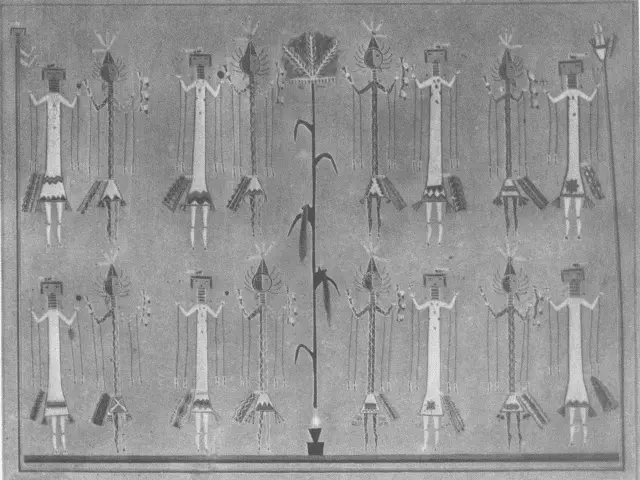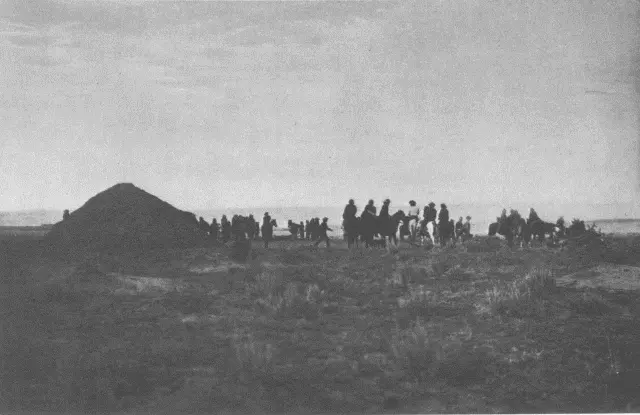Ninth and Final Day: To the average person and to the Indians as a whole the last day is the Yébĭchai dance. From a distance the Indians have been gathering during the two previous days, and the hospitality of the patient's family, as well as that of all the people living in the neighboring hogáns, is taxed to the utmost. And from early morning until dark the whole plain is dotted with horsemen coming singly and in groups. Great crowds gather at the contests given half a mile from the hogán, where horse-races, foot-races, groups of gamblers, and throngs of Indians riding wildly from race-track to hogán fill the day with hilarity and incidents memorable to all. Toward the end of the day preparation is made for the closing part of the nine-day rite. Great quantities of fuel have been brought from the distant plateau, and placed in many small piles at each side of the smooth dance ground to the east of the hogán. As soon as it is dark the fuel is ignited, making two long lines of camp-fires, furnishing both light to see the dancers and warmth to the spectators, for the Yébĭchai cannot be held until the autumn frosts begin, when the nights have the sharp, keen air of the high altitudes.

Zahadolzhá - Navaho
This is the last of the dry-paintings used in the Night Chant, being destroyed on the night of the eighth day's ceremonies. It takes its name from the fact that the principal characters represented in it, the dark figures, are all Zahadolzhá, Fringe-mouth Gods. According to the myth underlying the rite these gods made the first paintings of this sort used among the spirit people, and were the ones who furnished succor to the patients on the eighth day of the nine days' healing ceremony. The light figures are female deities—haschĕbaád. In the centre is the cornstalk, a life-giving symbol, and partially encircling the whole is the personified light-giving rainbow, a female personage.
During the ceremony a man masked as a Zahadolzhá places his hands first upon a part of his likeness pictured in colored earths and then on the corresponding part of the patient, as head, body, and limbs. Later the colored earths or sands are carried away in a blanket and placed under brush or trees toward the north.
With the gathering darkness the human tide flows toward the medicine hogán, illuminated in the dusk by the long lines of camp-fires. All gather about and close around the dance square, having to be kept back by those in charge. Men, women, and children sit on the ground near the fires. Many on horseback have ridden up, and form a veritable phalanx back of the sitting spectators. The dance does not begin at once, and those assembled spend the time telling stories, jesting, and gossiping. Belated arrivals make coffee, or do hurried cooking around the fires.
Some distance to the east of the dance ground is a brush enclosure where the dancers prepare for their part in the rite. There, too, is a fire for light and warmth. The men in preparation remove all clothing, save short kilts, and paint their bodies with a mixture of water and white clay. Anyone who may have experienced the enjoyment of a sponge bath out in the open on a cold, windy night can appreciate the pleasure of the dance preparation. The dancers are impersonators of Navaho myth characters, twelve usually taking part. No qualifications are necessary other than that the participant be conversant with the intricate ritual of the dance. The dance continues throughout the entire night, one group of men being followed by another. The first twelve men dance through four songs, retiring to the dressing enclosure for a very brief rest after each. Then they withdraw, and twelve others dance for a like period, and so on. The first group sometimes returns again later, and the different groups vie with one another in their efforts to give the most beautiful dance in harmony of movement and song, but there is no change in the step. The several sets have doubtless trained for weeks, and the most graceful take great pride in being pronounced the best dancers. The first group of grotesquely masked men is ready by nine or ten o'clock; they file into the dance enclosure led by Hasché̆ltĭ, their naked, clay-painted bodies glinting in the firelight. While wearing masks the performers never speak in words; they only sing or chant. To address one in conversation would incur the displeasure of the gods and invite disaster. Time is kept by the basket drum and the rhythm of the singing.
The white visitor will get his best impression of the dance from a short distance, and, if possible, a slight elevation. There he is in touch with the stillness of the night under the starry sky, and sees before him, in this little spot lighted out of the limitless desert, this strange ceremonial of supplication and thanksgiving, showing slight, if any, change from the same performance, held on perhaps the same spot by the ancestors of these people ages ago. As the night wears on the best group of dancers come out. They are, perhaps, from the Redrock country, or from some other far-away district, and have been practising for weeks, that they might excel in this dance. The most revered song of the Yébĭchai is the Bluebird song, which is sung at the approach of day, and is the closing act of the drama. With the last words, "Dóla anyí, dóla anyí," the assembled multitude start for their homes, near and far, melting into the gray of the desert morn, and by the time the sun breaks above the horizon the spot which was alive with people a few hours before is wrapped in death-like stillness, not a soul being within range of the eye.

Yébĭchai Hogán - Navaho
Table of Contents
The ceremony celebrating maturity of girls among the Navaho is held generally on the fourth night after the first evidence of the maiden's entrance into womanhood. On the first morning following the moment of this change in life the girl bathes and dresses in her finest clothes. Later she stretches herself face downward on a blanket just outside the hogán, with her head toward the door. A sister, aunt, or other female relation, if any happen to be close at hand, or if not, a male relative other than her father, then proceeds symbolically to remould her. Her arms and legs are straightened, her joints smoothed, and muscles pressed to make her truly shapely. After that the most industrious and energetic of the comely women in the immediate neighborhood is called in to dress the girl's hair in a particular form of knot and wrap it with deerskin strings, called tsĭklólh. Should there be any babies or little tots about the home, the girl goes to them, and, placing a hand under each ear, successively lifts them by the neck, to make them grow faster. Then she darts off toward the east, running out for about a quarter of a mile and back. This she does each morning until after the public ceremony. By so doing she is assured of continuing strong, lithe, and active throughout womanhood.
The four days preceding the night of the ceremony are days of abstinence; only such foods as mush and bread made from corn-meal may be eaten, nor may they contain any salt. To indulge in viands of a richer nature would be to invite laziness and an ugly form at a comparatively early age. The girl must also refrain from scratching her head or body, for marks made by her nails during this period would surely become ill-looking scars. All the women folk in the hogán begin grinding corn on the first day and continue at irregular intervals until the night of the third, when the meal is mixed into batter for a large corn-cake, which the mother bakes in a sort of bean-hole outside the hogán.
Читать дальше














